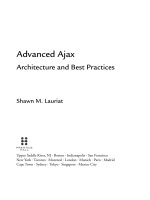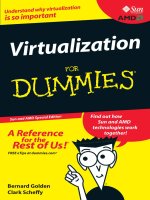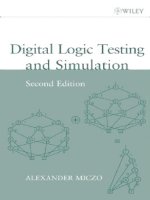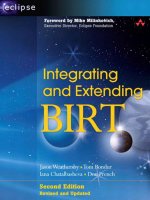Prentice hall programming oracle triggers and stored procedures 3rd edition dec 2003 ISBN 0130850330
Bạn đang xem bản rút gọn của tài liệu. Xem và tải ngay bản đầy đủ của tài liệu tại đây (2.69 MB, 573 trang )
ChapterOne.AnIntroductionto
RelationalDatabaseTables
1.1BEFORERELATIONALTABLES
1.2SQL
1.2.1ANSIStandard
1.2.2SQLDatabase
1.2.3SQLImplementation
1.2.4SQL*Plus
1.3TABLES
1.3.1DataModelView
1.3.2CreateTableScript
1.3.3DescribingtheTable
1.3.4TableData
1.4SQLSTATEMENTS
1.4.1DataDefinitionLanguage(DDL)
1.4.2DataManipulationLanguage(DML)
1.4.3TransactionControl
1.4.4SessionControl
1.4.5SystemControl
1.5TABLECOLUMNDATATYPES
1.5.1Character
1.5.2Number
1.5.3DATETypes
1.5.4LargeObjects
1.5.5XMLType
1.5.6LONGandRAWTypes
1.5.7ROWIDType
1.6BEHINDTABLES
1.6.1ApplicationTablespaces
1.6.2DataDictionary
1.1BeforeRelationalTables
In1969,ApolloastronautsNeilArmstrongandBuzzAldrin
walkedonthemoon.ThatsameyearDr.EdgarFrankCodd,
Ph.D.,developedthetheoryforrelationaldatabasesystems.
Shortlyafterthisdevelopment,Coddpublished"ARelational
ModelofDataforLargeSharedDataBanks"intheAssociation
ofComputingMachinery(ACM)journal,Communicationsofthe
ACM.Codd'smodelbecamethefoundationforaprototype;a
relationaldatabaseprojectwithinIBMcalledSystem/R.Studies
wereperformedattheIBMSanJoseResearchCenter(nowthe
AlmadenResearchCenter)andby1974IBMhadarunning
prototyperelationaldatabasesystem.Thissystemwasbased
onmultitablequeriesandmultiuseraccess.Themethodfor
accessingdatainSystem/RwascalledStructuredEnglishQuery
Language(SEQUEL).
Followingitsresearchanddevelopment,IBMreleasedSystem/R
asaprototype.ItwasusedbytheMITSloanSchoolof
Managementandcommercialorganizationswithinthe
manufacturingandinventorysectors.Theprojectdemonstrated
thatCodd'stheoriescouldbeappliedandimplementedinthe
realworld,butendedin1979.
ThesuccessofSystem/Rdidnotreceivequitethesame
attentiontheworldgavetheApolloastronautsonJuly20,
1969;but,System/R'ssuccesscreatedanewparadigminthe
worldofinformationtechnologyaparadigmthatdominatesthe
informationagetothisday.
Coddbelievedthatprogrammersshouldbeabletocontrolthe
exactdatausedtojoinandconstructqueriesfrommultiple
independenttables.Thiswasnotthecasewithexisting
hierarchicalandnetworkdatabases.Fortheseother
technologies,anapplicationprogrammerwouldcodean
algorithmtonavigatethroughthedatabasebyaccessingdata
recordsbasedonthepredefinednavigationpaths.Assoftware
requirementschanged,programmersfrequentlyneeded
databasemodificationstothesepathsandnewnavigations
pathsneededtobedefined.Thesoftwaredevelopmentprocess
wasslowandimpairedwithfrequentmeetingsondataaccess.
Codd'smodelhadabroadimpactonthesoftwaredevelopment
process.
System/Rwasimplementedbyagroupofhighlytalentedand
educatedsoftwareengineers.Theydemonstratedthatlarge
informationsystemscouldbebuiltonCodd'stheoryofmultiindependenttablesandastructuredquerylanguage.Thiswas
thebirthofSEQUEL.ThroughouttheSystem/Rproject,
engineersopenlypublishedtheirworkintechnicaljournalsand
atinternationalconferences.Thepolicyofopenpublicationis
consideredtohavebeenafactorinthesuccessof
System/Rleadingtothecreationofmanyrelationaldatabases
suchasDB2andOracle.
IBMpassedcontroloftheSystem/Rstructuredquerylanguage
totheAmericanNationalStandardsInstitute(ANSI),aprivate
nonprofitorganizationthatadministersU.S.voluntary
technologies.Becauseoftrademarklaws,thelanguagewas
renamedfromSEQUELtoSQLfor"StructuredQuery
Language."TodaySQLisanANSIstandardandanInternational
StandardsOrganization(ISO)standard.
In1977,agroupofengineerswhohadbeenfollowingthe
System/Rproject,primarilythroughpublications,recognizedits
potentialandformedacompany.Thiscompany,Software
DevelopmentLaboratories,waslaternamedRelational
Software.Thisnewcompanydevelopedandmarketedthefirst
commercialversionofarelationaldatabasemanagement
system,whichwasbasedontheANSISQLStandard.They
namedtheirproductOracle.
WhenprojectSystem/Rendedin1979,manyinformation
systemsreliedoneitherhierarchicalornetworkdatabase
architecture.Inthe1980s,manydevelopmentprojectsmoved
towardrelationaltechnology.Today,themajorityofnew
informationsystemsarerelational;however,hierarchicaland
networkdatabaseproductshavestillmaintainedamarket
presence.
IMS/DBistheflagshiphierarchicaldatabaseofIBM.Rockwell
InternationalandIBMdevelopedIMSin1969tomanagedata
fortheNationalAeronauticsandSpaceAdministration's
(NASA's)Apolloprogram.IMS/DBcontinuestodaywithasolid
internationalpresence.Itisindustry-wideandservesan
estimated200millionendusers.TheIMS/DBdatabaseserved
theApolloprogramincludingApollo11,whichsentArmstrong,
Aldrin,andpilotMikeCollinstothemoon.
ComputerAssociates'networkdatabaseproductisCA-IDMS,a
widelyuseddatabaseserving2,000sitesaroundtheworld.The
producthaschangedinnameandownershipbutcontinuesto
supportlargecorporatedatasystemsthatrunonIBMOS/390
platforms.
IDMShasaninterestinghistory.JohnJ.Cullinanefounded
CullinetSoftware,Inc.in1968.HeboughttherightstoIDMS,a
CODASYLdatabase,fromB.F.Goodrich.CODASYL,anacronym
forConferenceonDataSystemLanguages,wasestablishedin
1960bytheDepartmentofDefenseforthepurposeof
standardizinglanguagesandsoftwareapplications.Cullinetwas
thefirstsoftwarecompanytobelistedontheNewYorkStock
Exchange.ComputerAssociatespurchasedCullinetin
Septemberof1989andrenamedtheproductCA-IDMS.
AlthoughCA-IDMSisbasedondatabasenetworkarchitecture,
theproductincludesanANSI-compliantSQLOption.Thisoption
allowsapplicationstoaccessIDMSdatausingSQL.Asetof
comprehensivetoolsisavailablethatincludesagentsfor
enterprisemonitoring,paralleltransactionprocessingusingIBM
ParallelSysplexClusterTechnology,JDBCsupportforJava,and
manyothereBusinesstechnologies.ThemajorityofIDMS
applicationsarewritteninCOBOL.
Oracle,predominatelyknownfortheRelationalEnterprise
Server,ownstwoadditionaldatabaseproducts:(a)anetwork
databaseproductcalledDBMS,whichisaCODASYLdatabase,
and(b)arelationaldatabaseproductcalledRdb.BothRdband
DBMSwerepurchasedfromDigitalEquipmentCorporation
(DEC)priortotheacquisitionofDECbyCompaq.
OracleacquiredDBMSwhenitpurchasedtheRdbproduct
familyfromDEC.KenOlsen,anMITgraduate,hisbrotherStan,
andHarlanAndersonfoundedDEC.Inadditiontohardware
architecturessuchasthePDP-11,VAX,andAlpha,DEC
developedRdb,arelationaldatabase,andalsoDBMS,a
networkdatabase.Thenetworkdatabasewasrenamedfrom
VAX/DBMStoDECDBMSwhenversionV5.0wasreleasedon
theAlphaAXPplatform.
Oracle'sCODASYLDBMSisamulti-usernetworkdatabasethat,
likeRdb,isoptimizedfortheCompaqOpenVMSoperating
systemoneitheranAlphaorVAXarchitectureplatform.DBMS
ishighlysuitedformanufacturingsystemsandshopfloor
systemsthatrequirestableenvironmentswheredatabase
informationisfairlystatic.ConsilliumCorporation'sWorkStream
isthemostwidelyinstalledManufacturingExecutionSystem
(MES)inthesemiconductorandelectronicsindustries.
WorkStreamhasalonghistoryofrunningonVAX/DBMSand
todayrunsprimarilyonVAXandAlphaserversusingOracle
CODASYLDBMS.
Rdb7wasOracle'sfirstreleaseofRdbthatwasconceivedand
engineeredasanOracleproduct.Oracle'sRdb7isanenterprise
relationaldatabaseoptimizedfordigitalplatforms;thatis,the
Hewlett-PackardCorporation'sOpenVMSoperatingsystemand
CompaqDigitalUNIX.WhenCompaqacquiredDECitreplaced
theDECversionofUNIX,calledUltrix,withtheproductname
DIGITALUNIXanoperatingsystembasedona64-bit
architecturethatrunsonAlphaAXPplatforms.
Insummary,thedatabasemarketisclearlydominatedby
relationaltechnology;however,hierarchicalandnetwork
databasescontinuetomeettheneedsofenterprisenetwork
computingenvironments.IBMIMS/DBisadominant
hierarchicaldatabasethatcanservicehigh-transactionrates
andhasalargeinstallbase.TwonetworkdatabasesCA-IDMS,
licensedbyComputerAssociates,andDBMS,licensedby
Oracle,playcriticalrolesinsupportofhigh-transaction
enterprise-widesystems.InadditiontotheOracleEnterprise
Server,OracleCorporationalsoownsRdb7,arelational
database,andDBMS,anetworkdatabasebothproductsare
optimizedforCompaqplatforms,includingAlphaAXP.Todaythe
OracleDatabaseServeraddressestheneedsofsmallandlarge
businessesthatrequireinformationprocessingforonline
transactionprocessing(OLTP)systems,decisionsupport
systems(DSS),plustheeBusinesssolutions.Thesetypesof
applicationscanoperateonsmall,stand-aloneservers,oron
distributed,high-availabilityarchitectures.
1.2SQL
SQLmeanssomethingveryspecific,whereasthetermdatabase
hasbroadmeaningandinterpretationineverydayconversation.
ThissectionelaboratesontheSQLlanguageasastandard.
TopicsincludeSQLimplementation,embeddedSQL,DirectSQL,
andSQL*PlusasanimplementationofDirectSQL.
1.2.1ANSIStandard
SQLisalanguagecurrentlydefinedinanANSIstandard(the
previoussectiondiscussedthehistoryofSQLasitpassedfrom
IBMtoANSI).IfyouarewritinganOracleapplicationthatuses
SQL,thenyouarecodingSQLstatementswhosesyntax
complieswithANSI-X3.135-1999,"DatabaseLanguageSQL."
ThisANSIstandardisavailabletothepublicthroughtheANSI
Webstore.Youcanvisitthesite,
whichhasasearch
formfield.Usingthesearchfield,youcanfindSQLstandards
withasearchon"ANSIX3.135."Youcanobtaincopiesofthis
documentinPDFformat;thecost,asofthiswriting,is$18and
itcontainsabout600pages.
Thestandard,aswithmoststandards,isdefinedusingthe
BackusNaurFormsyntaxillustratednext.Thefollowingextract,
fromANSI-X3.135-1999,"DatabaseLanguageSQL,"isshown
heretoillustratetheprecisenesswithwhichthestandard
definesthesyntaxofaCREATETABLEstatement.
<tabledefinition>::=
CREATE[{GLOBAL)LOCAL}TEMPORARY]TABLE<tablename>
<tableelementlist>
[ONCOMMIT{DELETEIPRESERVE}ROWS]
<tableelementlist>::=
<leftparen><tableelement>
[{<comma><tableelement>}...]<rightparen>
<tableelement>::=
<columndefinition>
|<tableconstraintdefinition>
So,ifyouareadatabasevendorandyousellaSQLdatabase
product,thenyouaretellingyourcustomersthatyourdatabase
productiscapableofparsingandexecutingANSISQL
statements,suchastheaforementionedCREATETABLE
statement.
Thereisalwaysanadvantagetoworkingwithastandard.It
meansthatyourknowledgeistransferable.Anunderstandingof
SQLmeansthatyourknowledgeofrelationaldatabase
technologycantransferbetweenproductssuchasOracleand
SQLServer.Evenwithinastandardtherearedifferences.SQLis
noexception.
SQLdiffersacrossvendorsfortworeasons.First,thereare
"implementationdefined"featuresinthestandard;thatis,for
someSQLfeatures,thespecificnatureofhowafeatureis
implementedis"implementationdefined"thestandardexplicitly
statesthiswiththelanguage"implementationdefined."This
meansthevendorhasdiscretioninhowthefeatureis
implemented.Oneexampleishowthevendorimplementsthe
catalogordatadictionary.Thestandardcannotimposehowa
vendorstoresdatabasemetadata.We'llseelaterinthischapter
howOracle'sdatadictionaryisasetofrelationaltablesfrom
whichwecanselecttremendousamountsofinformation,such
asinformationdescribingthetableswecreate.
Asecondreasonwhytherearedifferencesacrossdatabasesis
duetothefactthatvendorsdoenhancetheirspecificSQL
engineswithadditionalcapabilitiesthattheyfeelbenefitthe
applicationdeveloper.OneexampleistheDECODESQLfunction
thatyouwillfindinOracle.Thisisapowerfulfunctionthatwill
notnecessarilyappearinotherdatabaseproductssimply
becauseDECODEisnotpartoftheANSIstandard.Another
exampleisthedatabasecolumntypeCURRENCYthatyoufind
inSQLServernotalldatabaseproductsprovideaCURRENCY
type.Thesedifferencesareminorcomparedtothemany
consistenciesacrossSQLproductsthatareensuredbytheANSI
standard.
Insummary,youwillfindvariationsinsomeSQLstatements
acrossdatabaseenginesthisisreallynotabigdeal.For
example,ifyoubuildyourexpertiseinSQLandyoubuildthis
knowledgeinOracle,thenyourknowledgewillincludean
understandingofinnerandouterjoins.Ifyouareever
confrontedwiththesyntaxofouterjoinsfromaSQLServeror
DB2application,wherethissyntaxvaries,thenyoucaneasily
maketheknowledgetransition.Thekeyissueistorecognize
thattherearedifferences,becauseyouarelikelytobecome
exposedtothesedifferencesatsomepointinyourcareer.
Whenthishappens,justrememberthatproductswillhave
subtledifferencesevenundertheumbrellaofanANSI
standard.
1.2.2SQLDatabase
Thetermdatabaseisusedoftenineverydaylanguage,butitis
importanttorememberthatnotall"databases"arecreated
equal.Norcantheyallbecalledrelationaldatabases.Theterm
relationaldatabasereferstoonebasedontheSQLstandard
thatiscapableofparsingandexecutingSQLstatements.We
canbeverygeneralinhowweusethetermdatabase,butthe
termrelationaldatabasedoesconveyadatabasethatisbased
ontheSQLstandardsomethingveryspecific.
Incontrasttorelationaldatabases,therearenonrelational
databases,suchasDBMS.DBMSisadatabaseproductlicensed
byOracleandisnotarelationaldatabaseitisanetwork
database.AccesstoDBMSisthroughalanguagesimilartoSQL,
butitisnotSQLperANSIstandard.Somedatabases,suchas
IDMS,arenotrelationaldatabases,yettheyprovideafrontend
thatallowsanapplicationtoaccessthedatausingSQL.Having
aSQLfront-endcapabilitydoesnotmakeIDMSarelational
database.Arelationaldatabaseisrelationalwhenitconformsto
theminimumrequirementsoftheANSISQLstandard.
OracleisafullySQL-compliantdatabase.AnOracledatabase
consistsofmanyfilesthatarepreferablydistributedacross
severaldiskpartitionsdistributingfilesminimizesIOcontention.
1.2.3SQLImplementation
GiventhatOracleisarelationaldatabaseandweaccessOracle
datausingSQL,howdoesonecreateandmanipulatethatdata?
YoucouldwriteaVisualBasic,C,Perl,orJavaprogram.You
couldwritejustaboutanyprograminanylanguageyouwant
andembedSQLstatementsinyourprogram.Thesestatements
willinsertdata,changeit,anddeleteit.Ourapplication
programscanpotentiallyexecuteanyvalidSQLstatement
againstourrelationaldatabase.
SQL,originallycalledSEQUEL,designedbyIBM,andbasedon
Codd'srelationaltheory,provideddataaccessmethodsforthe
System/Rproject.TheprimarypurposeofSQLtodayisthatwe
useitinamannersimilartowhichitwasusedbySystem/R;
thatis,tobeembeddedwithinaprogramminglanguageandto
providedataaccessmethodsagainstdatabasetablesfora
productionsystem.Onecoredifference,fromaday-to-day
codingperspective,betweenprogramsoftodayandthoseof
System/Risthatwearemorelikelytouseamorecurrent
programminglanguage,suchasJavaorC#.Secondly,
programswecodetodayutilizeenhancementstotheSQL
standardsthisincludesthekeycomponentsofthistext:
Databaseconstraints
Triggers
Storedprocedures
Supposeyoujustwanttodosomethingsimpleandquick.Let's
sayyouwanttocreateatablewithonecolumnandinsertone
rowintothattable.Forsuchasimpletask,theefforttocode
andcompileaprogramseemsexcessiveanditis.Forasimple
SQLinterfaceweusetoolsthataddressthe"directinvocationof
SQL."TheSQLstandardaddressesembeddedSQLandthisis
whathasbeendiscusseduptothispoint,embeddingSQL
statementswithincompilerlanguageprogramsbuttheSQL
standardalsoaddressesanothermethodreferredtoasDirect
SQL.Thisiswherewedothesimpleandquickstuff.
TheSQLStandardspecifiesthreeapproachestoSQL:
embeddedSQL,modularSQL,andDirectSQL.Embeddedand
modularSQLareprincipaltechniquesforapplications
developmentusingacompilerlanguagetheyaregreatfor
applicationsdevelopmentbutimpracticalforsimpletasksand
forlearningtheSQLlanguage.
IfwedidnothaveanimplementationofDirectSQLandwanted
toseealltherowsofatable,wewouldhavetowritean
applicationprogram,embedaSQLcursor,fetcheachrowinto
localvariablesandprintthosevariablesouttosomedefault
device.AtoolthatimplementsDirectSQLallowsustodisplay
thesamedatainabout5secondsmostlylimitedtohowfastwe
cantypeordrag-and-drop.Ratherthanacompiledprogram,
DirectSQLallowsustotypeaSQLSELECTstatementwhereby
allrowsareflushedtoourscreenforviewing.
TheANSIstandarddescriptionofdirectSQLisstatedinthe
following:
DirectinvocationofSQLisamechanismforexecuting
directSQL-statements,knownas
invoking<directSQLstatement>s,themethodofraising
conditionsthatresultfromtheexecutionof
informationthatresultsfromtheexecutionof
implementation-defined.
NoticethatDirectSQLis"implementationdefined,"hence
vendorshavewidediscretioninhowtheyimplementDirect
SQL.SQL*Plus®isanOracleimplementationofDirectSQL,as
isSQLServer'sQueryAnalyzer.Thesetoolsdifferinuser
interface;however,thesameSQLquerystatement,executed
acrossdifferenttools,willproducethesameresultset;thatis,
thesamedataandnumberofrowswillbethesame.
ThereexistsawidevarietyofSQLtoolsthatimplementdirect
SQL.ThesetoolsallowustotypebasicSQLstatementsand
executethemwithouttheadditionalcomplexityofacompileror
scriptinglanguage.SomeareGUIandsomeprovideabasic
commandlineinterface.ExamplesofsuchtoolsareSQL*Plus,
whichisbundledwiththeOracledatabasesoftware;SQL
Navigator®,whichislicensedbyQuestSoftware,SQL
WorksheetwhichisbundledwiththeOracleEnterpriseManager
(OEM)software;andTOAD,whichisalsoaQuestSoftware
product.Therearemanyothertoolsaswell.
ThereisaconceptualdifferencebetweenaccessingOracle,or
anyrelationaldatabase,throughacompilerlanguagesuchas
JavaandusingadirectquerytoollikeTOADorSQL*Plus.All
toolsthatimplementDirectSQLoperatewithinaninteractive
frameworksoyouneedtokeepthefollowingtwopointsin
mind.First,whenyouexecuteaquerywithSQL*Plus,orwith
anydirectSQLtool,theresultsaredumpedtoyourscreen.
Secondly,whenexecutingthesamequerywithinanapplication,
youmustdevelopcodetocapturetheresultsofyourquery.
ThisisillustratedwiththefollowingtwoSQLquerystatements.
ThefirstSQLstatementisaquerythatyouwouldexecutein
SQL*Plus.Uponexecutionofthestatement;thestudentname
isflushedtothescreen.
1.SELECTstudent_nameFROMregistered_studentsWHEREstudent_i
TheaforementionedSELECTstatementisavalidSQLstatement
forDirectSQLonly.ItwillnotcompileasanembeddedSQL
statementwithinacompiledprogram.TheSELECTstatement
embeddedinanapplicationprogramwillbeslightlydifferentthe
differenceistheadditionalINTOclause,shownnext.TheINTO
clausewillreferenceaprogramvariableintowhichthestudent
nameistobecopied.
[Viewfullwidth]
2.SELECTstudent_nameINTOmy_program_variableFROMregistered
='A101';
Therearevariationsontheaforementionedquerythatusethe
INTOclausewehaveexplicitcursors,cursorloops,andother
optionsthesetopicsarecoveredinChapter11.Itishelpfulto
keepinmindthatSQL*Plus,likeToadandotherdirectSQL
tools,isprimarilyaninteractivetoolyoudonotworryabout
capturingresultdata.Ontheotherhand,applicationprograms
docapturequeryresultdataandwhenyoudevelopcodeto
"capturedata"youhavedesignissues:multiplerowsreturned
exceptionconditionsthesetopicsareaddressedthroughoutthe
text.
1.2.4SQL*Plus
InadditiontobeinganimplementationofDirectSQL,SQL*Plus
isatrademarkednameforanOracleexecutableprogramthat
runsasacommandlineinteractiveprogram.Asmentionedin
Section1.2.3,therearemanySQLtoolsonecanusetoexecute
SQLagainstadatabase.We'vementionedSQL*Plus,Toad,SQL
Navigator,andSQLWorksheet.Infact,youcanuseSQLServer
SQLQueryAnalyzertorunyourqueriesagainstyourOracle
database.Youhavemanychoices.Thistextmakesuseof
SQL*Plus,butyou'llhavenodifficultyfollowingalongshould
youuseanothertoolforinteractingwithOracle.
SQL*Plusprimarilyservesanenduserinaclient/server
environment.Figure1-1illustratesacommonconfigurationthat
includesSQL*Plus.Inthisfigure,thecommunicationprotocol
acrossthisnetworkistheOracleNet8protocol.TheOracle
softwarethatrunsonyourclientsendstheSQLstatement
acrossthenetworktothedatabaseanditisOraclesoftware,on
thebackend,thatforwardsthedatabacktotheclient.Ifyou
runSQL*PlusandtypethefollowingSQLstatement:
SELECTstudent_nameFROMregistered_studentsWHEREstudent_id=
Figure1-1.SQL*PlusinaClient/ServerMode.
theSQLstatement,exactlyasyoutypeit,includingthesame
case,issentacrossinanetworkpackettotheOracleserver.
Theprocessedresult,thatbeingalistofstudentnames(inthis
caseprobablyjusttheonenameofthestudentwiththat
particularstudentID),isreturnedtotheSQL*Plusclientwhere
itisflushedtoyourscreen.
ThesendingandreceivingofdataisOracleNet8,whichis
OraclecommunicationsoftwareandrunsoverTCP/IP,orother
networkprotocols.SQL*PlusiswrittentoutilizeNet8,which
utilizesTCP/IPoverthenetwork.
SELECT,INSERT,UPDATE,andDELETEarethemostcommon
SQLstatementstheyarethecoremeansofmanipulatingdata.
Inadditiontothesecoredatamanipulationstatements,theSQL
standardincludesthespecificationforstatementslike:CREATE
DATABASE,ALTERDATABASE,CREATETABLE,CREATEVIEW,
CREATETRIGGER,andmanyotherSQLcommands.Anyvalid
SQLstatementcanbeexecutedfromSQL*Plus,includingthe
ALTERDATABASEstatement.So,allSQLstatements,notjust
thecommonINSERT,UPDATE,DELETE,SELECTcanbe
executedfromSQL*Plus.
TherearemanyadvantagestolearningSQL*Plus.Afeware
summarizedhere.
YouwillfindSQL*PlusintheOraclebindirectoryofevery
Oracleinstall.Ifyouinstallthedatabaseonanenterprise
server,youwillfindSQL*Plusinthebindirectory.Ifyou
installjusttheOracledevelopersoftwareonthedesktop,
youalsohaveSQL*Plus.Thisexecutableprogramisalways
there.So,intheabsenceofhavinganyothertools,youcan
alwaysbesureyouhavetheSQL*Plusprogram.
BecauseSQL*PlushasbeenavailablefromOraclethrough
somanyversions,theprogramhasanextremelywideuser
base.Itispopularforseveralreasons,oneofwhichisthe
factthatithasbeenaroundforsomanyyears.
SQL*Plusisasimplecommandlineinterfaceprogram.It's
notaGUIinterface;youdonothavemultiplescrollable
windowsthatshowtheSQLstatementinonewindowand
thequeryresultinanotherwindow.AlthoughGUIfeatures
havetheiradvantages,thesimplicityofSQL*Plusbecomes
advantageouswhenyouneedtobuildscripts.Youcanbuild
alibraryofSQL*Plusscripts,eachanASCIItextfile,and
thosescriptswillrunonOracleinUNIXoronOraclein
Windows.
SQL*Plushasallthefeaturesofapowerfulscripting
language.Itsupportsargumentpassing,commandfiles,
andnestedcommandfiles.Youcanhostouttoother
languages(e.g.,embedaWindowsscripthostfileorKorn
shellscriptwithinaSQL*Plusscript).SQL*Plusscriptscan
beincorporatedintootherscriptingprograms(i.e.,
SQL*PlusscriptscanbeembeddedinKornshellscripts;
illustratedinChapter2).Thesefeaturesmakethelanguage
highlyusefulfortoolbuilding.
Insummary,althoughSQL*Plusisanexcellenttooltofirst
experienceSQLandOracle,itisalsowidelyusedasa
developmentandadministrationtool.Peoplewhouse
SQL*PlusinitiallyuseittointroducethemselvestoOracle,
butyearslaterthey'restillusingitforapplications
developmentanddatabaseadministration.
1.3Tables
Databasetablesarethemostfundamentalstructureina
database.IfyouwereaskedtoworkonanewOracledatabase,
youwouldinitiallywonderhowmanytablesthereareinthe
application.Itmakesadifferencewhethertherearesixtables
or600tables,atleastintermsofhowmuchthereisforyouto
learnabouttheapplicationbeforeyoucanbeaproductive
developer.
Theexamplesinthistextarebasedonademostudentdata
model.Themodelstoresdataforstudents,courses,and
professors.Chapter4graphicallyillustratesthismodelincluding
theSQLcreatescripts.Akeytableinthismodelisthe
STUDENTStable.
AninitialplanforaSTUDENTStablerequiresansweringthe
question:"Whatattributesshouldbestoredforeachstudent?"
AninitialdraftofaSTUDENTStableincludestheseattributes:
Attribute
ColumnName
Auniquestudentnumber.Eachstudentisassignedanumberusedto
accessbillingandregistrationrecords.
STUDENT_ID
Astudentname.
STUDENT_NAME
AmajorfieldofstudysuchasScienceorHistory.
COLLEGE_MAJOR
Acollegeenrollmentstatusindicatingadegree-seekingorcertificateseekingstudent.
STATUS
Tableshavedifferentrepresentations.Originally,thetableisa
logicalentityconsistingofaboxonanentityrelationship
diagram.Inproduction,thetablecanbedescribedwiththe
SQL*PlusDescribecommandandrowscanbeselected.
1.3.1DataModelView
Thedatamodelviewofatableidentifiesthelogicalattributesof
theentitybeingstoredinthedatabase(Figure1-2).This
includesakeyattribute,whichistheprimarykey.Theprimary
keyisuniqueforeachinstanceoftheentity.Ifthetablestores
students,everystudentwillhaveauniqueprimarykey.The
datamodelviewisagraphicalrepresentation.
Figure1-2.StudentsTableinaDataModel.
1.3.2CreateTableScript
Oncethemodeliscompleteandallattributesaredefined,the
entitymustbecreatedinthedatabase.SQLisusedtocreatea
table.Thissteptransitionsthelogicalconcepttoaphysical
tableinthedatabase.WhenSQLcreatesobjects,suchas
tables,thisiscalledDataDefinitionLanguage(DDL).The
followingDDLcreatesaSTUDENTStableanddefinesthe
columntypeofeachattributetobeavariablelengthstringwith
amaximumsize.
CREATETABLEstudents
(student_idVARCHAR2(10),
student_nameVARCHAR2(30),
college_majorVARCHAR2(15),
statusVARCHAR2(15));
1.3.3DescribingtheTable
Thedefinitionofatablecaneasilybedescribedwiththe
SQL*Pluscommand.Thiscommandretrievesinformationfrom
thedatadictionaryinaformatthatconveystheinformation
storedinthetable.IftheDDLintheprevioussectionwereused
tocreatetheSTUDENTStable,theSQL*Plusdescribecommand
wouldreturnthefollowing:
SQL>descstudents
NameNull?Type
----------------------------------------------------STUDENT_IDNOTNULLVARCHAR2(10)
STUDENT_NAMENOTNULLVARCHAR2(30)
COLLEGE_MAJORNOTNULLVARCHAR2(15)
STATUSNOTNULLVARCHAR2(15)
1.3.4TableData
SQLstatementsthatmanipulaterowsinthetablearecalled
DataManipulationLanguage(DML).Oncethetableiscreated,
wecanaddstudentstothesystemwithINSERTstatements.
INSERTINTOstudents
VALUES('A101','John','Biology','Degree');
Akeycomponentofrelationaltechnology,emphasizedin
Section1.1,isthefreedomoftheprogrammertochoosewhat
datatoquery.Oncethetableiscreatedandrowsareinserted,
thereisnorestrictionwithdataaccess.Wecanqueryall
studentswithinaparticularmajor.Wecanqueryallstudents
whoaredegreecandidates.Wecanqueryalldegree-seeking
studentsmajoringineitherbiologyorhistory.
SELECTstudent_nameFROMstudentsWHEREcollege_major='Biolog
SELECTstudent_nameFROMstudentsWHEREstatus='Degree';
SELECTstudent_nameFROMstudentsWHERE
status='Degree'AND(college_major='Biology'ORcollege_major
Innetworkandhierarchicaldatabasetechnologies,the
programmercannot,atthelastminute,decidetoquerydatain
aparticularorder.Innetworkandhierarchicaldatabases,
orderedqueryresultsmustbebuiltintothedatabasestructure.
Inrelationaldatabaseswecan,asdevelopers,choosetoselect
studentsandtheirmajorinalphabeticalorder,reverse
alphabeticalorder,orderbyname,andorderbymajorwehave
norestriction.Theorderingofdataisnotinthedatabasebut
withintheSQLstatement.Sotopullallstudentnamesand
theirmajorinalphabeticalorder,weusetheORDERBYclause,
whichisacomponentoftheSQLspecification.Showingthis
orderedlist,weuse:
SELECTstudent_name,majorFROMstudentORDERBYstudent_name;
AllrowsofatablecanbeselectedwiththeSELECT*syntax.
ThefollowingistheSQL*Plussessionoutputthatselectsall
rowsfromthisSTUDENTStableafterfivestudentshavebeen
added.
SQL>SELECT*FROMstudents;
STUDENT_IDSTUDENT_NAMECOLLEGE_MAJORSTATUS
-------------------------------------------------A101JohnBiologyDegree
A102MaryMath/ScienceDegree
A103KathrynHistoryDegree
A104StevenBiologyDegree
A105WilliamEnglishDegree
1.4SQLStatements
TheSQLlanguageisprimarilyusedtocreatetablesand
manipulatetabledata;however,thelanguageincludes
statementsthatperformotherfunctions.SQLstatementsare
usedtocreatedatabaseaccounts,sizeandtunefor
performance,andperformadministrationtasks.AnOracle
databasefirstcomesintoexistencewithaSQLstatement,the
CREATEDATABASEstatement.Thefollowingdescribesthe
categoriesofSQLstatements.
1.4.1DataDefinitionLanguage(DDL)
CREATETABLEisaDDLstatement.DDLstatementsdefineour
databaseobjectsandresultinupdatestotheOracledata
dictionary.Theycreate,modify,anddeleteobjectssuchasa
tables,views,storedprocedures,databasetriggers,database
links,anddozensofotherobjectsinthedatabase.
DDLstatementscanalterexistingdatabaseobjectsincluding
tables.ColumnsandconstraintscanbeaddedwiththeALTER
TABLEcommand.Shouldwechoosetoaddacolumnfora
student'sagewecanexecutethefollowingSQLstatement,
whichaltersthedefinitionofthetableinthedatabasedata
dictionary.
ALTERTABLEstudentsADD(ageNUMBER(3));
1.4.2DataManipulationLanguage(DML)
DMLmanipulatesdatawiththefollowingstatements:
INSERT
UPDATE
DELETE
SELECT
SELECTstatementsdonotactuallymanipulatedata,butthe
SELECTstatementisoftenincludedwithintheconversational
contextof"DML."
AnOracledatabaseprovidestablechangesthroughINSERT,
UPDATE,andDELETEtocohabitatewithSELECTstatements.
TheconceptsupportedinanOracleenvironmentiscalled
consistentreadimage.Ausermakinguncommittedchangesto
thedatabasethroughINSERT,UPDATE,andDELETEstatements
doesnotblockauserwhoissuesaSELECTduringthatsame
timeframe.TransactionssuchasanINSERTthatarenot
committedtothedatabasedonotinterferewithconcurrent
SELECTstatementsagainstthesametables.ASELECT
statementisguaranteedaconsistentimage.Theresults
returnedtotheuserfromaSELECTstatementareguaranteed
tobefromthemostrecentconsistentimage,whichwillbethe
rowsasofthemostrecentCOMMIT.ACOMMITstatement
establishesanewcheckpointbywhichtabledataisupdatedto
aconsistentpointintime.
1.4.3TransactionControl
Transactioncontrolstatementsallowyoutobundleagroupof
DMLstatementsunderanall-or-nothingdomain.Thatis,"all
statementscompletesuccessfully,"orifonestatementfails,
thenallstatementsfailasonegroup.Examplesoftransaction
controlstatementsare:SETTRANSACTION,COMMIT,and
ROLLBACK.
1.4.4SessionControl
SessionControlstatementsaretemporaryandpersistforthe
durationoftheuser'sdatabaseconnection.AusefulSQLtuning
practiceistoturnSQLtraceonforthesession.Thisrecords
sessioninformationtoauserdumpdirectoryforSQLstatement
analysisusingtheOracletool,TKPROF.Thefollowingwillturn
tracingon/offforthesession.
ALTERSESSIONSETSQLTRACE[TRUE|FALSE]
OnceSQLTraceison,theuserrunstheapplication.During
executionOraclewritesdatatoatracefile.Thetracefilecanbe
analyzedusingtheOracleutility,TKPROF.Thefollowingshows
thehostcommandstringtoparsethetracefile.Theresultafter
runningTKPROFisanoutputASCIIfileshowingeachSQL
statementrunwithdetailtuninginformation.
tkproforacle_trace_file.trcoracle_output_trace_file.prf
explain=SCOTT/TIGER@ORAsys=no
Thefollowingisacommonaltersessioncommand.Italtersthe
defaultdisplayformatforcolumnswithaDATEtypetoinclude:
day,month,year,hours,minutes,andseconds.
ALTERSESSIONSETNLS_DATE_FORMAT='dd-mon-yyyyhh24:mi:ss';









